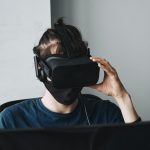
What is E- Learning?
Knowledge is power and E- learning is what has got that power to the public like never before. E-learning or online learning is known to have made education and training accessible to everybody. Online learning breaks the barriers posed by location and time when it comes to traditional classroom learning with a teacher and blackboard. Online learning classes can be taken from anywhere in the world at any time and by anyone. With growing for information and education the E-learning business is booming. Companies are relying on E-training for on-boarding and up-skilling their employees, it is a convenient and safe option given the need of the hour. E learning is known for its accessible nature which gives the learner freedom and control over the pace of their learning.
With the huge amounts of information carried in such courses, it can be quite overwhelming to absorb for the learner . This is where Immersive learning comes in and how VR kicks the effects of E-learning up a notch and helps a learner reach their full potential.
What is Immersive Learning?
Immersive Learning is the future.
Immersive learning takes learning to another level and reinventing its meaning entirely. As compared to its traditional face to face classroom learning counterparts, or the middle ground with E- Learning, Immersive Learning is the form of learning that has redefined education and training.
Most institutes and companies are now tapping into the potential that Immersive learning has to offer.
So, what exactly is Immersive Learning?
Immersive Learning is the result of Virtual Reality. Virtual reality is a computer-generated 3D simulation which can be explored by putting on VR headsets. VR is a form of Extended Reality (XR) and can be associated with Augmented Reality (AR) and Mixed Reality (MR).
Virtual Reality can be experienced through VR headsets like Oculus Quest, Google cardboard, Samsung Gear VR, etc. VR is increasingly making its mark in the learning and training arena. When experiencing a simulation through VR, an individual is immersed into the situation as they are surrounded 360°.
Staff at the Children’s hospital, Los Angeles collaborated with the VR Division at Oculus to make a training simulation for emergencies where surgeons have to treat young patients who are suffering from seizure or anaphylactic shock. This virtual experience gives the surgeons a sense of real urgency where they learn to deal with the situation hands on, while also giving safe space for making mistakes to be able to learn from. They are closely monitored by L&D specialists in order to improve their skills.
The user is in a simulation which is relevant to their field of training, for example, soft skills training, safety training etc. According to PWC, training that takes 2 hours in a classroom setting and 45 minutes in a E-learning course, takes 29 minutes in a VR training course.
Since VR training involves fully immersing the user in the training, its impacts reach far beyond time effectiveness.
Immersive learning and the rise of Remote work
At the present moment, 4.7 million people are working remotely which is 3.4 of the population. Remote work is freeing and employees working from home are said to be healthier, have better job satisfaction and earn more. Remote work is turning out to be good for businesses as well with 80% of businesses confirming remotely working employees have better productivity due to the flexible nature of WFH.
To compensate for the lack of face to face and on the job training due to remote work, companies are now striving to compensate for training their employees at home through E- Training. E-training is another one of the word heavy courses that remote employees have to add to their workload. If the employees could be compensated for time and effort through a more engaging lesson? This is where VR comes in.
When Virtual Reality is combined with E-Learning, employees get a chance to be fully immersed yet fully focused on the simulation. It is time efficient while also giving a chance to the learner to get up from their stagnant workplace and move around. According to PWC, Immersive learning makes employees 4 times more focused on their work as compared to E- learning. This can be very helpful for new employees at this time.
Immersive Learning & E learning go hand-in-hand
E learning with all its benefits lacks the oomph element. To keep the user engaged and excited is hard to achieve when the content is being delivered by a monotonous flow of information. This is the reason for the information not sticking to the learner. Through bringing in VR into the booming E-learning scenario, the learner is brought out of the traditional learning methods and put into scenarios where the learning sticks to them for longer than ever imagined.
In order for your company to leverage the entirety of what Immersive Learning has to offer, this is how you can combine your VR with E-Learning modules-
Personalised Scenarios
Having employees be involved in scenarios specific to their roles and needs helps them be more connected to the training as they get to experience first hand situations and act accordingly.
Immersive Online training
Emulate safety training or soft skills training with your VR in order to remove distractions by completely immersing the user through all their senses in the virtual reality simulations.
Analytics and Measurement
Through VR combined with E-Learning courses, the evaluation of the results as well as interest and improvement is enhanced helping the L&D keep track of the training of their employees as well as give helpful personalized feedback.
Immersive training builds its path towards a high ROI through having employees, remote or otherwise, be fully connected to their training.
Written by Lauren Tizzone
Similar articles to check out:







